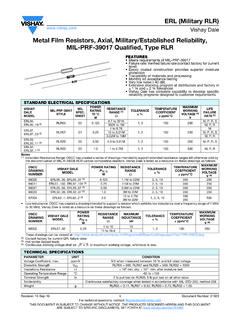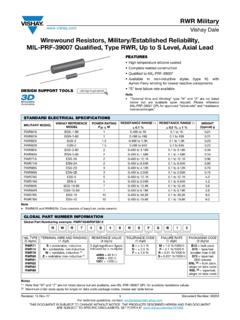Transcription of TUTORIAL 1: Welcome to ANSYS! Opening the ANSYS …
1 TUTORIAL 1: Welcome to ANSYS ! Opening the ANSYS Workbench Environment From the program menu list open the ANSYS folder and select Workbench Once ANSYS is active and you have closed the popup window presented, you will be able to view the Project tab. This view should look like the view below. Setting the UNITS. Now is a good time to set the units you are going to work with since the units typically do not change. Doing this now will prevent you from modeling a bar 2 meters in diameter and 12 meters in length when you try to model a bar 2 inches in diameter and 12 inches in length. The first bar may fail under its own self-weight depending on the material used! To change the units, or to check the units being used in an existing model, click on Units from the Project menu bar. You should see the following basic options for your unit system . We will typically use either the predefined Metric units (default unit system) or the US Customary units in our models.
2 At this point switch the units to the US Customary unit system by selecting it. The check mark should move to this Unit system in the menu shown. Also Switch to Display Values in Project Units instead of as Defined, if this check mark is not already checked. Creating the Model To perform a structural analysis, which is what we are focusing on in Strengths, you will need to add the correct building block (system) from the Analysis Systems menu, which is the left-hand side (LHS) menu in the Project window that is currently open. ANSYS can do an amazing number of different types of analyses, including thermal, dynamic, buckling, fluid interaction, etc., but our focus is on Static Structural analysis, , our systems are not moving and will only have static (unchanging) forces applied. This type of analysis will allow us to determine the resulting displacements, stresses, strains, and internal forces/moments in any structural component that are caused by loads that are assumed to vary slowly with respect to time.
3 This is exactly the same type of results information we are looking for when we solve Strength of Materials problems by hand using theoretical and/or approximate methods. Click on the Static Structural item in the LHS menu, drag it into the Project Schematic window and then drop it off specifically in the region defined by the green dashed box that appears. In a few seconds you will see the following small window appear. This is the model system block. Typically you will give your system a new name that will allow you and others to pick this specific model out of many others quickly in the future. To do this double click on the default name on the system and change the name. For example you can rename the model YourName_Axial_Bar_Tutorial. This process defines a specific system block that is made up of several components that are called cells. These cells define the sequential steps needed to perform the specific type of analysis.
4 To perform your analysis, you will work through the cells of each system in order typically from top to bottom defining inputs, specifying project parameters, running your simulation, and investigating the results. To interact with the cells, you will typically do one of the following: Single-click: Single-click an object to select it. This does not modify data or initiate any action. Double-click: Double-click an object to initiate the default action, which may later help you increase your speed. Right- click: Right-click to display a context menu applicable to the current state of the selected object. Saving Your Model & any Future Analyses Before you go any further, save your current ANSYS workspace and system by selecting File->Save As from the toolbar. Save your files to a folder that is on the desktop or to a folder on the CEE Scratch Drive. You can store files to a memory key also, but this may slow things done a little.
5 As you continue through the different program elements be sure to save your work from time to time in case anything bad happens and you need to go back to a previous saved model. ANSYS does not have an Undo button so having previous saved versions can be useful in helping you avoid starting from scratch if something goes wrong. Time to Start Modeling! To create a model in ANSYS and then analyze it you will work through the cells in the System menu in top- to-bottom order. This means that you need to define the Engineering Data and Geometry before you can put together the Model, and you must have the Model defined before you can run the analysis and get the Solution and view the Results. To help you understand these cells and the process needed to create each one of the System Components we will create a model of a solid, circular steel axial bar. The bar has a diameter of 1 inch, a length of 12 inches, a concentrated load, P = 10,000 lbf at one end and is fixed to a wall at the other end.
6 This axial bar setup is shown in the picture below. To create the model we will need to define the material used Steel; the geometry of the bar length and cross-sectional shape and dimensions; the loading force magnitude and direction; the boundary conditions the type of support provided and the support locations; and the type of mesh element and the coarseness of the mesh used to analyze the system. A coarser mesh and simpler elements will provide less accurate results than a more refined mesh and more complex elements, but the coarser mesh will provide quicker analysis results as a tradeoff. The analysis part is straightforward once the model has been defined. Engineering Data To have the correct behavior modeled, you need to define the type of material, along with its mechanical properties, using the Engineering Data cell. The model deformation response will depend on the material defined.
7 To view the default Steel material properties, right-click on the Engineering Data cell and select Edit You will see the following as the default. In some cases you will not see the bottom graph axes, which is just fine. Some of the numbers may look familiar, especially in this set of units, but we will set the material properties to reflect that we are using a standard A992 Steel material. The primary material properties that we need to specify are the Modulus of Elasticity, E = 29,000,000 psi and Poisson's Ratio, = These will allow the correct relationship to exist between stress and strain in the model and when we run our hand calculations to check the results obtained. Other critical material properties that our analysis needs are the steel yield strength of 50,000 psi (50 ksi) and the steel ultimate strength of 65,000 psi (65 ksi). Although our bar will not yield due to having a stress below the material yield stress, it is important to define these material behavior limits in case the stress is enough to cause yielding to occur.
8 Yielding will lead to very large deflections typically, so knowing if something has yielded becomes an important design consideration. These values are different from the default values provided by ANSYS and so you will need to change these. The A992 steel density is the same as the default ANSYS steel material and will be used in problems where we include the self-weight of the material as part of the loading. To change each value, click on each of the cells in the lower left pane and then enter the value desired in the box that appear in the upper right pane. Remember the units are psi here. To change E and click on the +. sign in front of the Isotropic Elasticity menu item to open up its options. Then click on each cell to enter 29000000 for E and for . Use the same process to change both the tensile and compressive yield strength to 50000 and the tensile and compressive ultimate strength to 65000.
9 When you are done you should have the values shown in the screenshot below for our specific Steel material. Save the changes with Save. To return to the Project tab either close the A2: Engineering Data (X) tab or click on the grayed-out Project tab to the left of the A2:engineering Data tab and leave the Engineering Data tab open, but hidden. This action will take you back to the overall ANSYS project window. The Engineering Data cell in your axial Bar System menu should now have a green check mark next to it. Geometry During this semester, you will either create a new geometry from scratch using the DesignModeler program or you will import an existing geometry previously created by you or a colleague. We will jump right in and create our geometry for this axial bar model from scratch. To do this right click on the Geometry cell in the System menu and select New Geometry. This will open the DesignModeler program in a new window.
10 This may take a little while depending on the computer you are working on but in the end you will see that a new window has been opened (with the green bullet and DM icon). This window should look like the one below. Note Sketching Tab & Modeling Tab You should notice that the LHS menu now presents a Tree Outline. The Tree Outline matches the logical sequence of simulation steps. Object sub-branches relate to the main object. For example, an analysis environment object, such as Static Structural, will eventually contain loads. You can right-click on an object to open a context menu that relates to that object. You can rename objects prior to and following the solution process. Using the DesignModeler we will draw' our system part(s) using basic drawing tools and then extrude our 2D cross-sections into 3D elements. To do this now, follow these steps: First, change the Units from the default of m to inch using the toolbar Units if you notice that the units on the window scale are in shown in m instead of inch.











